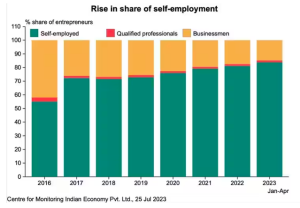Context:
The latest data from the Centre for Monitoring Indian Economy (CMIE) suggests that In just three years from January-April 2019 to 2023, India’s workforce experienced a significant expansion, the number of self-employed businesspersons witnessed an impressive increase during this period.
Trends In Employment In India:

The “business” class in India can be compressed into three main sub-categories:
Rise of Self-Employment:

Findings on data analysis:
What should India do?
Conclusion:
India’s next 30 years belong to its potential if reforms are accelerated and flagship programs like Skill India, Make in India, and Start-up India yield desired outcomes. Focusing on labor-intensive manufacturing and human capital can make India a global labor force source.
| Additional Information:
India’s Demographic Advantage:
To harness the demographic dividend, the focus should be on improving labor force participation, employability, and creating employment opportunities for the youth. |
News Source: The Indian Express
Context:
What is a simultaneous election/One Nation One Election?
| Background of simultaneous elections: In India, general elections for the House of the People and State Legislative Assemblies were held simultaneously in 1951-52, 1957, 1962, and 1967.
Reasons for break in simultaneous election cycle:
|
Benefits of simultaneous elections:
Impediments raised by Ministry of Law and Justice in implementation of Simultaneous Elections:
Way Forward:
News Source: Indian Express
Context:
The Centre’s Fiscal deficit increased to Rs 4.51 lakh crore in April-June from Rs 2.10 lakh crore in April-May, according to data released by the Controller General of Accounts.
About Fiscal Deficit:
Components of the Fiscal Deficit:
Positive Aspects of Fiscal Deficit:
Negative Aspects of Fiscal Deficit:
News Source: The Hindu
Context:
The Government of Odisha has notified three Biodiversity Heritage Sites(BHS) i.e. Mandasaru Hills, Mahendragiri Hills and Gandhamardan Hills.
About Biodiversity Heritage Sites:
Mandasaru Hills:
Mahendragiri:
Gandhamardan Hills:
|
News Source: PIB
Context:
The Constitution (Jammu and Kashmir) Scheduled Tribes Order (Amendment) Bill, 2023 seeks to include “Gadda Brahmin”, “Koli”, “Paddari Tribe”, and “Pahari Ethnic Group” in the list of Scheduled Tribes (STs) in Jammu and Kashmir.
Process for Inclusion in the ST List:
Criteria for Specification of Scheduled Tribes in India:
Pahari Ethnic Group:
Paddari Tribe:
|
News Source: The Indian Express
Context:
In June 2023, seven out of the eight core sectors, which make up the Index of Industrial Production, experienced an increase in their performance.
About Index of Industrial Production (IIP):
Eight Core Sectors:
Significance of IIP:
Index of Industrial Production vs Annual Survey of Industries (ASI)
|
News Source : The Hindu
|
|
|
|
Context:
FSSAI directed states and union territories to intensify surveillance of fresh produce due to mounting concerns over high concentrations of harmful pesticides and chemicals in vegetables and fruit sold in markets.
About FSSAI:
Governance of FSSAI:
News Source: Livemint
SC Verdict on Newsclick Shows Adherence to Due Pro...
Stay Invested: On Chabahar and India-Iran Relation...
Credit Rating Agencies, Impact on India’s De...
Catapulting Indian Biopharma Industry
Globalisation Under Threat, US Import Tariffs Have...
Global Report on Hypertension, Global Insights and...
<div class="new-fform">
</div>
